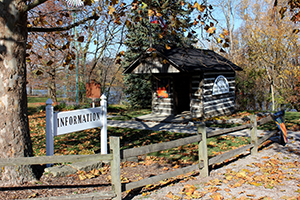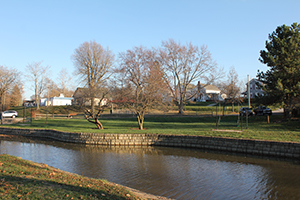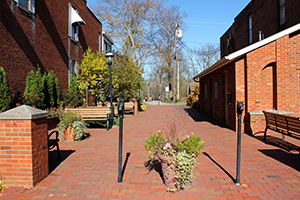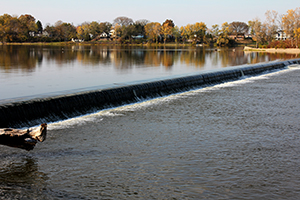
The Maumee River Looking West From the Bridge
Welcome to our Village Walk. This walk was developed by the late June Huffman. We start our journey traveling south over the The Maumee River bridge.
Before there were bridges, ferries, resembling flat barges, transported horse-drawn wagons and passengers across the river. Old stories say the ferries were unreliable since the ferrymen weren’t always on duty, thanks to their love of strong drink.

The Mighty Maumee River Looking East From the Bridge

The Dominick Labino Marker
We are now approaching Front St. To the left is the Dominick Labino Historical Marker. A resident of Grand Rapids for many years, he was a glass scientist, engineer, artist and inventor. Credited with 57 patents, “Nick” invented pure silica fiber which was used in insulating tiles covering the space shuttle Columbia and the Apollo, Mercury, and Gemini spacecrafts. As a glass artist, Mr. Labino was co-founder of the studio glass movement in America. His art works are in over 60 museums in the U. S. and abroad.
Directly across the highway you’ll notice a small bungalow surrounded by masses of flowering blooms. Known as an English Garden, it is open to public viewing when the “Open” sign is posted in the front yard.

The Isaac Ludwig Mill
Now we turn right onto Front St. From this vantage point you see the front of the Isaac Ludwig Mill. Other names associated with the mill include Peter Manor, who built the mill and also the first white man to live on the north bank; Augustine Pilliod; Frank Heising and his son, Cleo. Cleo Heising, the last private owner, sold the mill in 1971. Isaac Ludwig’s grandson, Cleo Ludwig, founder of the L-K Restaurant chain, purchased the old landmark and deeded it to Toledo Metroparks in memory of his grandfather. The mill, where grain is still milled and where logs are sawed into lumber, has been repaired, repainted, and converted into a working museum for the education and enjoyment of visitors who come to the park. During periods of high water residents watch the water level in millrace intake to see if flooding is imminent.

Sign Board Showing an Active Village
On your right you’ll notice the Organization Sign Board which bears the logos of Grand Rapids organizations and churches. Considering a population of around 1,000, the logos indicate a very lively village.

The Railroad Bridge going over the river
The railroad, which came to Grand Rapids in 1877, actually caused the beginning of failure for the canal system. The present railroad bridge was built around 1920 and is still used by the Bluebird Passenger Train, transporting occupants back to a time when the railroad was helping open up this part of the country.

Log Cabin Tourist Center
Turning toward the river we see the log cabin, herb garden, and windmill which surrounds it. Created by the Grand Rapids Historical Society to serve as a Welcome Center, a rack of Northwest Ohio information brochures is placed there for your convenience. Also, an historical marker tells the story of Grand Rapids’ survival despite fire and floods.

The Beautiful Maumee River Just North of the Sidecut Canal Towpath – A Walk You Won’t Want to Miss
At this point you gain a sweeping view of the Maumee River. The State Dam in the distance was first built of wood in1838 to hold back water to feed the canal system. It was rebuilt of concrete in 1908 when the State attempted to pump new life into its canals. The canals failed completely in 1913 when statewide flooding caused severe damage to the canal banks.

Bluebell Island and Park
The rolling green on your right is Bluebell Park.
Bluebell Island, for which the park was named, is located in the old Miami and Erie Sidecut Canal basin where canal boats once turned around before heading west on their return trip to the main leg of the Miami and Erie Canal across the river. The site is one of the most serene spots in Grand Rapids and is a favorite picture taking location. The island area was filled in due to erosion on the banks.

Mill House B & B
The Mill House, presently a bed and breakfast, was originally known as Stump’s Mill, a steam-powered facility, when it was built around 1900. Long lines of horse-drawn wagons and cars pulling trailers lined the street as farmers waited their turns to have grain reduced to flour or livestock feed.

Front Street Shopping District
The Shopping District is a surprising example of a restored working Victorian Village where fancy brickwork, elaborate moldings and transom windows are reminders of days gone by. Just about postcard-perfect, you’re able to browse in specialty shops where a selection of fine merchandise awaits you. If you’re hungry, a wide variety of food ranging from fine to casual dining is available. If ice cream, candy, or espresso coffee is your favorite, that’s available too. The Village Apothecary, built in 1896, has been placed on The National Register of Historic Places.

In 2002 the Shopping district underwent an overhaul. New streets and sidewalks were put in. We added new lights, trees, and landscaping. At the west end of the project, a new clock and flag pole were added.

Lincoln Street Park, a brick lined park where public restrooms, a water fountain, and benches await you, is located in the heart of the business district. This location also serves as an entryway to the recently beautified canal bank and towpath.

The Towpath Along the Sidecut Canal
Back in the 1830s when talk of constructing the Miami and Erie Canal began, the residents of Gilead learned the canal would follow the Maumee River’s north bank. The townspeople complained bitterly until the State of Ohio built a side-cut feeder canal to service Gilead (Later renamed Grand Rapids) people. If you give your imagination a workout as you walk the towpath yourself, you can see mules pulling their cargoes along the Gilead Side-Cut leg of the Miami and Erie Canal.

City Park
Howard Park once was home to commercial establishments such as general stores and hardwares. Grain elevators, warehouses and loading docks also lined the canal banks. A flurry of canal boats loaded and unloaded their cargoes here. Eventually, the buildings were destroyed and the land was presented to the town for a park. It provides a natural setting where veterans’ groups conduct Memorial Day services each year.
Howard Park is also where apple butter is stirred on the second Sunday in October when the Historical Society holds its famous Applebutter Fest. Up to 70,000 persons fill the village to attend this fest.

Town Hall & Theatre
The Town Hall (adjacent to City Park) was built in 1898 to house government offices, a jail, and an opera house for those seeking a higher degree of refinement. Grand Rapids became known as one of the finest facilities on the theatrical circuit. Besides plays, many other fancy affairs were held there, and if you give your imagination a little play, you can see ladies in long, flowing dresses stepping down from buggies. Escorted by properly dressed gentlemen, they hustle inside for an evening of quality entertainment. The building has been placed on the National Register of Historical Places. Here we also pass one of two full service marinas servicing the community, one with a newly constructed boat docking area.
The end of Front Street is where the Huffman Ice House used to stand on the quarry. In the winter the Huffmans and other men in the community cut ice from the quarry and stored it in the ice house to use in the summer. The ice was packed in saw dust to keep it from thawing.

The Wichman House
Now standing at the end of Front Street is a fine example of adaptive reuse. The main part of the Wichman House is an old granary that Mr. Wichman rescued from its country location. It still has bin marks on the interior walls. The rear portion of the house was another farm building. That now serves as a garage. The enclosed porch on the west side, still another farm building in its former life, has original beams. These three old buildings, knuckled together, create an outstanding house that is beautifully decorated to represent a country motif.

The former Sisters of Thurston B & B Nestled In the Trees
Turning left on Beech Street, at the intersection of Beech and Second Streets on the South side are two old homes. The one on the left is the former Sisters of Thurston Bed and Breakfast, so named for the Thurston family who lived there for many years. It was built by Dr. Mead.

The Gabriel Guyer House
Looking to the right, the house you see is reputed to be the oldest house in Grand Rapids. It was built by Gabriel Guyer, but has been added on to in recent years.

The Jacob Heeter House
A right turn onto Second Street brings you to the Jacob Heeter House, also known as the Ginger Bread House. Listed on the National Register of Historic Places, this house was built in the 1870s and architecturally is Gothic Revival in style. The house was renovated beginning in 1990. It has a spacious lawn in the rear which complements the lovely plantings in the front.

The State Dam After a few Days of Rain
Further on is Mary Jane Thurston State Park. Originally fourteen acres, the land for this park was given by Mary Jane Thurston. She once pastured cows near the river. The focal point of the park is the shelter house that was built by WPA labor during the 1930s, and the dam that was rebuilt in 1908 when the State of Ohio intended to revitalize the canal system. The park now boasts 555 acres of land that front 20 miles of the Maumee River. Mary Jane is a perfect place for boating, picnicking, fishing, tent and RV camping in Summer and sledding in the Winter. Boat launches and the park office are located at a large marina on Rt. 65 just east of Grand Rapids. If one continued west on St. Rt. 65 they would find the second full service marina.
Turning back into town we find our way to Third Street. The CIC Industrial Park is home to several industrial facilities.

The Kerr House
Going east on Third Street we find a place where potatoes were once raised on the Third and Beaver Streets hill. A striking Queen Anne brick mansion with many sprouting chimneys is located here. Since 1980, the facility has been known as The Kerr House, a nationally known health retreat where men and women concerned about their health and well-being trade the pressures of the real world for periods of relaxation and rejuvenation in a quiet, elegant setting. The house was built in the 1880s by B. F. Kerr, a local merchant. The Kerr House is also listed on the National Register of Historic Places.
Continuing east on Third Street, and making a northward turn onto Mill Street and a short walk returns us to the main business district on Front Street. Beyond the business district to the east you’ll notice a mix of architecturally significant houses on the bluff overlooking Front Street. Most have been restored in the past few years. Using old photographs as guides, they appear as original as they were when they were first built. The first house on the right is a two-story Greek Revival house built around 1860. It has had many additions added over the years including the enclosed front porch. It was formerly the home of Dr. A. J. Gardner, one of Grand Rapids’ earliest doctors, who also operated a pharmacy-novelty store.

On the National Register of Historic Places
Next is an Italianate residence built in 1883 by Richard Housely, a prominent businessman, for his southern bride. It served as a private residence until the 1950s when it was converted into apartments. In the late 1990s, it was lavishly refurbished by a private owner. The home has been placed on the National Register of Historic Places. In back is a dazzling rose garden attended to by the owners.

The Gruber House
The third house on the right was built in 1860 and is of Greek Revival design. It was owned by the Gruber family until 1886 when Howard Evans, a local hardware merchant purchased the property. It has changed hands twice since, and recently underwent historic improvements. Walking further up Front Street we find several more houses of Greek Revival design.
If we turned right onto Wapakoneta Road we would be headed for a visit to the Seven Eagles Historical Center which is about one mile out of town. Instead, we will wait to turn until we get back to Bridge Street. Here we turn right and find Grand Rapids Elementary School, the community pool, the Grand Rapids branch of the Weston Public Library, the community ball diamonds, and Labino Park, where there are newly resurfaced tennis an multi-purpose courts.
An easy drive a few miles east of Grand Rapids brings us to Otsego Park and the renovated Nazareth Hall.
We hope you have enjoyed this virtual tour of our Restored Canal Town. Please tell others and plan to visit soon in person!
Some Village History
Used with permission from the Grand Rapids Chamber of Commerce Brochure
The Perfect Blend . . . Past — with the Present . . . Truly Perfect!
The head of the great rapids of the Maumee has been a strategic gathering place for centuries, attracting early aborigines along with heroes and villains of the settlement period. It is a place of great natural beauty, as well as an ideal location for commerce to develop. The Howard family settled the site in 1822, while Peter Manor laid the foundations for Providence across the river.
Gilead was first platted in 1833 but was overshadowed during the canal period by Providence. Disease and fire ravaged Providence and left Gilead to grow and prosper. To gain a more sophisticated name, the village was renamed Grand Rapids in 1868. The railroad arrived a decade later and soon Grand Rapids became a commercial hub for settlers in the surrounding area.
Fire destroyed nearly the entire downtown at one time or another, and spring floods posed an annual threat. The 1904 and 1913 floods were especially destructive, and in 1959 water filled the downtown in five minutes and left men to scramble atop the roof of the Ludwig Mill visitor center.
Special events highlight the year in Grand Rapids. The flood watch of Spring draws thousands to view in awe the power of Mother Nature. Rapids Rally Days add fun and frolic to mid-summer. The fall season brings color tours to the river valley and the very successful Applebutter Fest. Finally, the Christmas Season brings festive decorations, the Open House Celebration, and a glimpse of Christmas long ago.
The visitor will also find an array of activities geared to people of all ages. Providence Metropark offers the Isaac Ludwig Mill, a restored water-powered saw and grist mill. Also at the park one can take a trip through time on an authentic mule-drawn canal boat ride through a working, original canal lock. Just down the road from the village proper is Mary Jane Thurston State Park and Marina, which provides a beautiful location for a picnic, camping or a walk along the canal towpath.
Since 1976, a slow but steady pace of restoration and renovation has begun in the village, returning the face of downtown to its turn of the century beauty. Today shops, stores, emporiums and restaurants fill the street of the restored, working village.
Grand Rapids is the perfect blend of the past with the present and promises you a nostalgic visit any time of the year. Come visit historic Grand Rapids. South and west of Toledo, Grand Rapids is easily accessible from many directions.
